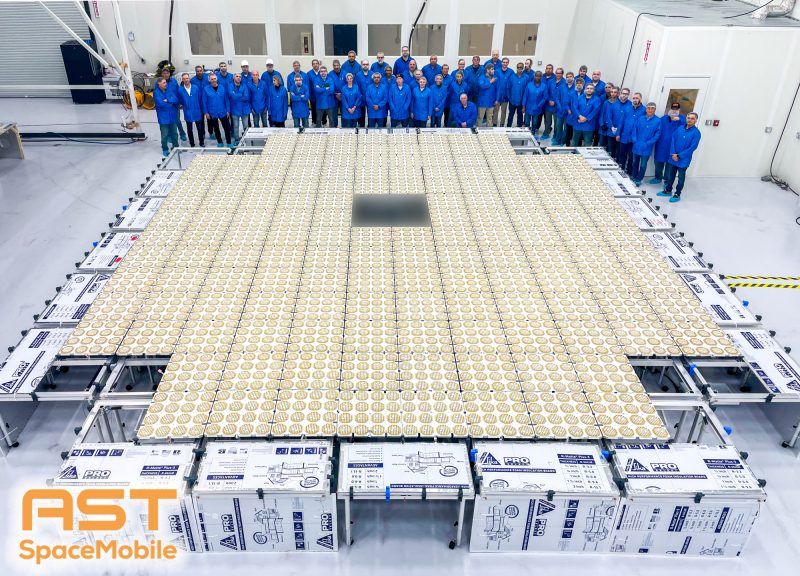
Launches: BlueWalker 3 satellite heads to orbit
Though he didn’t bother to elaborate, SpaceX CEO Elon Musk tweeted that the launch of AST SpaceMobile‘s massive BlueWalker 3 satellite – which lifted off Saturday, September 10, 2022 from Kennedy Space Center in Florida aboard a Falcon 9 – was one of his company’s toughest jobs yet.
One of our most complex missions
— Elon Musk (@elonmusk) September 9, 2022
Perhaps it was the mass of BlueWalker-3, which weighs in at about 1.5 tons, that had SpaceX pushing its envelope. The satellite is bound to be heavy. When unpacked in orbit it will cover an immense area, according to the AST SpaceMobile’s website, which described final preparations for the launch:
Over the summer, AST SpaceMobile completed the assembly and stowing of BW3, including its 693-square-foot (64.4-square-meter) phased array of antennas, at the company’s Midland, TX, headquarters and manufacturing facility. This large array of antennas is designed to connect directly to existing mobile phones from a much longer distance than traditional cell towers. In total, more than 800 tests were conducted on the satellite before it left Texas.
Like an orbiting raft of cell phone towers
AST SpaceMobile claims that many of the world’s five billion cell phone users have spotty broadband cell coverage. And, it says, its service will solve this problem. The company says it will extend broadband service to more billions of people who lack it entirely. But, as we’ve seen so often in recent years with the near-continuous launch of SpaceX’s Starlink satellites, these services will come at a cost to Earth’s night sky. Writing in the Duluth News Tribune, Bob King (aka AstroBob) wrote of the BlueWalker 3 satellite:
Think of it as an orbiting raft of cell phone towers.
Before it becomes fully operational, engineers will conduct tests to demonstrate that the technology works in low Earth orbit in coordination with infrastructure on the ground. Testing locations include the company’s home state of Texas, along with Hawaii and AST’s cellular partners in Europe, Japan, South America, Africa and Asia.
And BlueWalker 3 isn’t AST SpaceMobile’s biggest planned satellite. The company intends to orbit more than 100 commercial satellites even larger than BlueWalker 3. Called BlueBirds, these more-giant satellites should start launching by 2024:
Concurrent with the launch of BW3, AST SpaceMobile continues to build out its manufacturing capabilities to reach its goal of building six next-generation BlueBird satellites per month. The company intends to launch a low Earth orbit constellation of BlueBirds that would provide cellular broadband from space across the globe – on land, at sea and in the air.
Just leaving the nest!
???????????? pic.twitter.com/ugAXzcY7G8— Abel Avellan (@AbelAvellan) July 19, 2022
Bright in our skies
In other words, no part of the globe will remain unaffected by AST SpaceMobile’s constellation of extremely large and reflective satellites. And this fact has astronomers worried about the sanctity of the night sky. Bob King wrote:
While [the number of planned Bluebirds] pales in comparison to the current (and planned) number of Starlinks, BlueBirds will be considerably larger and therefore likely much brighter, making a significant addition to the number of bright satellites tracking through the night sky. Some observers expect them to become the second brightest objects after the International Space Station.
The venerable astronomy periodical Sky & Telescope has also sounded the alarm:
Astronomers at the Vera Rubin Observatory and the International Astronomical Union’s Centre for the Protection of Dark and Quiet Skies from Satellite Constellation Interference (IAU CPS) are concerned because these new spacecraft will interfere with celestial observations, adding to the problems already caused by other [satellite] constellations.
S&T’s editors – who provide information on how to find BW3, estimate its brightness and report sightings along with their warning – are calling for action on the part of amateur astronomers to keep an eye on the new satellite constellation:
BlueWalker 3 is expected to be among the brightest objects in the night sky after the antenna unfolds. Amateur astronomers can help record this satellite’s brightness, bringing awareness to bright satellites’ effects on our night sky and on astronomy.
Bottom line: AST SpaceMobile’s BlueWalker 3 communications satellite successfully launched to orbit on September 10, 2022. Astronomers are concerned.











